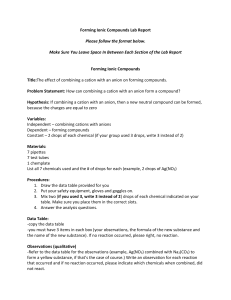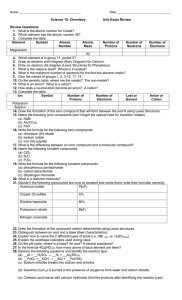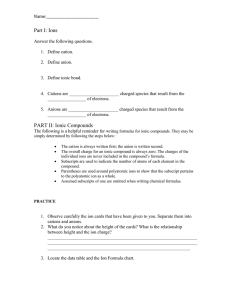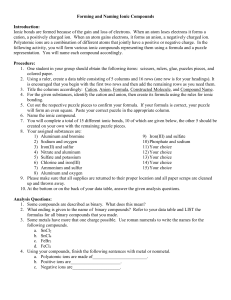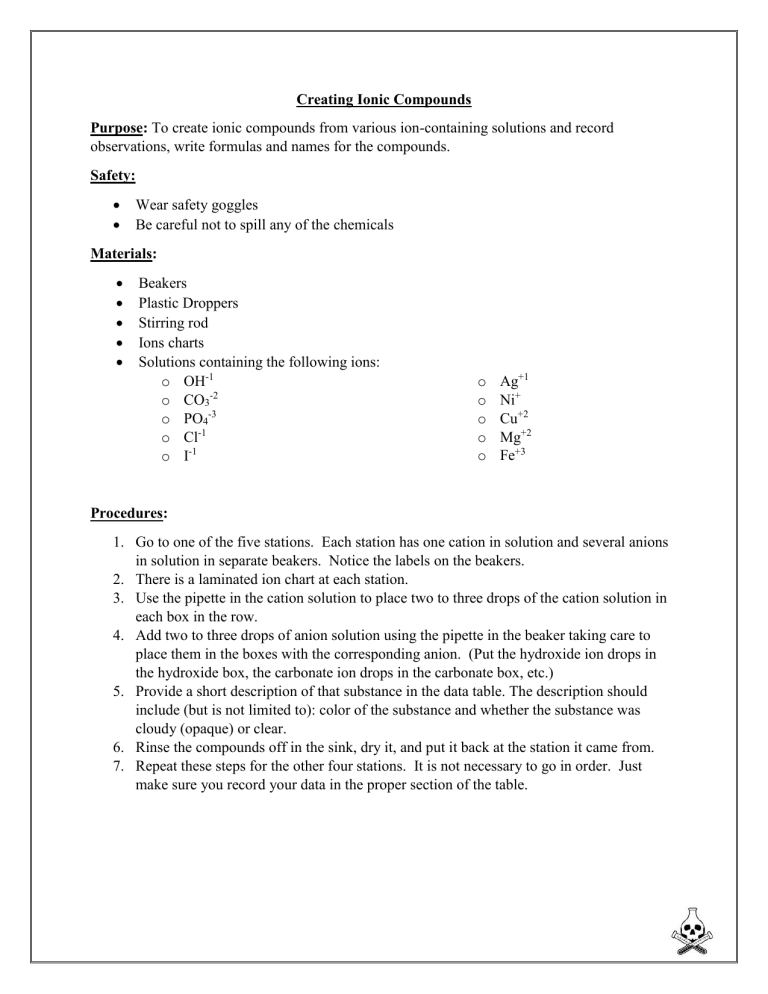
Creating Ionic Compounds Purpose: To create ionic compounds from various ion-containing solutions and record observations, write formulas and names for the compounds. Safety: Wear safety goggles Be careful not to spill any of the chemicals Materials: Beakers Plastic Droppers Stirring rod Ions charts Solutions containing the following ions: o OH-1 o CO3-2 o PO4-3 o Cl-1 o I-1 o o o o o Ag+1 Ni+ Cu+2 Mg+2 Fe+3 Procedures: 1. Go to one of the five stations. Each station has one cation in solution and several anions in solution in separate beakers. Notice the labels on the beakers. 2. There is a laminated ion chart at each station. 3. Use the pipette in the cation solution to place two to three drops of the cation solution in each box in the row. 4. Add two to three drops of anion solution using the pipette in the beaker taking care to place them in the boxes with the corresponding anion. (Put the hydroxide ion drops in the hydroxide box, the carbonate ion drops in the carbonate box, etc.) 5. Provide a short description of that substance in the data table. The description should include (but is not limited to): color of the substance and whether the substance was cloudy (opaque) or clear. 6. Rinse the compounds off in the sink, dry it, and put it back at the station it came from. 7. Repeat these steps for the other four stations. It is not necessary to go in order. Just make sure you record your data in the proper section of the table. Name: Date: Period: Unit 5 Ionic Compounds Pre-Lab and Data Table Pre-Lab Questions 1. The combining of the positive and negative ions within the solutions in this lab form a precipitate. We formed precipitates in our first lab this year. Define the term precipitate in your own words and include what type of compound they are. 2. Why is a Roman numeral required in the name of certain metallic ions? 3. Look at the ions on the material list. Was there an exception to that rule in this lab? If so, what was it? Cation Anion Description Station 1 Station 2 Station 3 Station 4 Station 5 GROUP WORK ENDS HERE!! How to Write the Lab Report Using the CER Method Create a data table similar to the one you used while doing the lab but add a column for the formula and another column for the name of the compound. See the sample heading below. Add 19 lines for the combinations of ions you created. Station Cation Anion Description Formula Name Completely fill out the table by copying what you recorded when you did the lab then write the correct formulas and names for each compound. This completed data table contains the information you will use to write “E” statements for the prompt. Select one compound from each station to address the prompt using the Claim-EvidenceReasoning method of writing critically. This means you will have five CER statements written under the data table in your lab report. The Prompt Is: Verify that ionic compounds were made in this lab. Do this for each of the compounds you selected. Make certain to identify in each claim which cation and anion combination you chose. Example of a CER response: Claim: At station X, Ca2+ and O2- reacted to form calcium oxide which is an ionic compound. Evidence: Two liquid solutions produced a white precipitate. Reasoning: Ionic compounds are formed when cations react with anions. Calcium is a metal; all metals form cations due to losing electrons. Oxide is the anion that results from oxygen gaining electrons. DUE DATE:________________________________________
